Injunction Against the DMV: Prevent Transfer of Title to Your Car
If you are concerned someone will sell or give away your vehicle without permission, you can file a “Courtesy Stop” request with the DMV to put a 60 day hold on transfers. Before you can do that, however, you must first start a lawsuit against the DMV and the person threatening to sell or give away your car. The DMV is only part of the case for the purpose of asking for an injunction preventing transfer.
Templates and Forms
If you need to start a case by filing a complaint:
This Guide with templates provides you with instructions to write and file the Complaint and to file the Courtesy Stop request, and information about next steps.
Step-by-Step Instructions
1
Research and Write Your Complaint and Accompanying Papers
Write the Complaint. You must sue the person or people who are threatening to change the title to your car. Often, the appropriate legal reason for the lawsuit is “conversion,” meaning someone has your vehicle and refuses to return it. You can find examples of a simple complaint for conversion in the self-help book Win Your Lawsuit, pages 88 and 89. However, there are many other possible causes of action (legal theories) that might apply in specific cases. There is a list of resources at the end of this Guide which can help you research the appropriate causes of action.
Whatever theory you use, be sure to specifically request the return of the vehicle, or the judge will assume that a monetary award is acceptable to you, and deny the injunction.
Include one cause of action for injunction against the director of the DMV: Whatever other causes of action you use, you must also include one cause of action for an injunction against the DMV director. A customizable template including this cause of action can be downloaded from the Law Library’s website, and a sample is attached at the end of this Guide. You will need to fill in any blanks (gray boxes) to fit the specific facts of your case. This cause of action is the part that allows you to get the Stop Notice.
You will also need to fill out two Judicial Council forms: Summons (SUM-100) and Civil Case Cover Sheet (CM-010). These are required in all cases.
2
File the Lawsuit and Pay the Filing Fee
Make three copies of the Complaint, Summons, and Civil Case Cover Sheet. Staple each of the copies, but leave the original unstapled so that it can easily be scanned by the clerk.
Filing Fee and Fee Waiver
If you qualify for a fee waiver, you can file without paying the fee by including a fee waiver request with your complaint. See our Fee Waiver guide for more information.
Take them to the Gordon D. Schaber Courthouse at 720 9th St., Sacramento, CA 95814. You will file them in the drop box along with the filing fee. Only an unlimited case can include an injunction, so you will have to pay unlimited case fee (at the time of this writing, it was $435). You can check current fees at Fees and Forms.
3
Deliver a copy of the File-Stamped Complaint and the Courtesy Stop Request to the DMV
Once you have the file-stamped Complaint, you can attach it to a Courtesy Stop Request (REG-500) and send it to the DMV to prevent title from being transferred for 60 days. You can fax it to 916-657-6056, or mail or deliver it to:
Department of Motor Vehicles
Registration Operations Division
Field Office Support Unit
Attn: Courtesy Stops
2415 First Ave., MS C250
Sacramento CA 95818
This automatically stops the DMV from transferring title for 60 days. If you don’t have your injunction by then, you can get a 60-day extension by submitting a new Courtesy Stop Request along with a file-stamped copy of your notice of motion showing the date of your upcoming injunction hearing (see Step 4, below).
You still need to officially serve the DMV with the Complaint in order to move the case forward. This step just gets the Courtesy Stop Request in effect right away.
4
Reserve a Hearing Date for your Motion for Preliminary Injunction
The Complaint gets the case started. However, you must also file a Motion for Preliminary Injunction with the court to get the injunction you need.
Determining the Department and the Time of the Motion
In Sacramento, most motions are heard in either Department 53 at 2:00 p.m. or Department 54 at 9:00 a.m. When you file the Complaint, the clerk will provide you with the department your case is assigned to.
Choose a date.
In Sacramento County, the party who files a motion reserves a date via the court’s Case Portal. There are two things you must get done before the hearing, and you must pick a date that gives you time to do both:
- File the papers in court sixteen court (business) days before the hearing date
- Serve the other party(s) sixteen court (business) days plus five calendar days if you serve by mail before the hearing date.
As long as you have time to do both, you can choose any date that works best for you.
An easy option is to choose a date at least 35 days away. This will give you plenty of time to prepare and get the papers served and filed.
If you need to have the Motion heard sooner than that, follow the instructions the Law Library’s guide, to find the soonest date that gives you time to file and serve the papers.
Remember, you can get a 60-day Courtesy Stop as soon as you file the papers, so in most cases there should be no urgency for the hearing – as long as you set it up right away.
Filing Deadline: The Motion must be filed with the court at least sixteen court days prior to the motion date (California Code of Civil Procedure (CCP) § 1005). Court days are Monday through Friday, excluding court holidays. To determine whether a particular filing date will meet this deadline, start with your desired hearing date and count backward (CCP § 12c) sixteen court days. Day one is the court day prior to the hearing. The sixteenth court day prior to the hearing is the last possible date that the Motion can be filed with the court.
For example, suppose you wanted to have your Motion heard on June 18, 2012. You would start counting backward using June 15, 2012 as day one. Do not count weekends or court holidays (there is one court holiday in this example, which is Memorial Day, May 28). Your sixteenth court day before the hearing would be May 24, 2012, which would be the last day that the Motion could be filed.
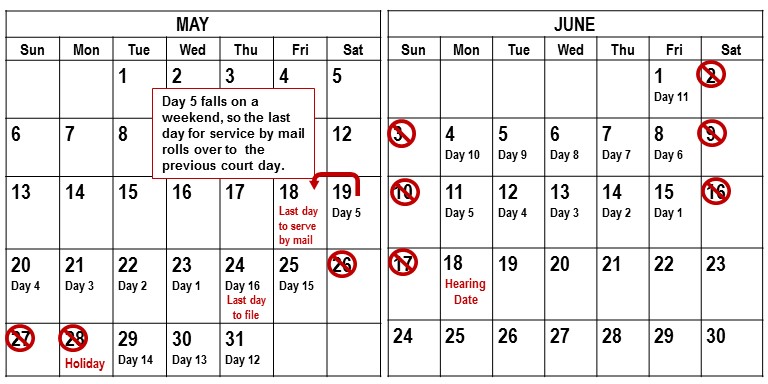
Service Deadline: All attorneys or self-represented parties in a case must be served with a copy of the Motion. This means that someone over the age of 18 who is not a party in the case must either personally deliver a copy of the Motion and related documents to the attorney or self-represented party or mail a copy of the Motion and related documents to the party by first class mail.
If the Motion is personally served, the service must be at least sixteen court days prior to the date of the Motion, the same as the minimum filing deadline.
What if my Motion date is after the 60-day DMV stop runs out?
Request an extension of the DMV’s Courtesy Stop by submitting the request form a second time, with a copy of the notice of Motion showing the date your Motion is scheduled. The stop will be extended.
If the Motion is served by first-class mail, additional calendar days are added before the sixteen court days—an additional five calendar days if mailed within California, ten if mailed to an address in another state, and twenty if mailed to another country. (CCP § 1005). Calendar days include weekends and holidays, but if the final day lands on a weekend or holiday, it is rolled over to the previous court day. So, if June 18, 2012 was the hearing date, the sixteenth court day before would be May 24, 2012, but counting back five more calendar days results in Saturday, May 19, 2012. Because the fifth day fell on a weekend (or holiday), the deadline for service rolls back to May 18, 2012, the last court day before the mailing deadline.
When choosing the date for your Motion, be sure that you have left enough time for the Motion to be both filed and served.
5
Research and Write Your Motion for Preliminary Injunction
The Motion consists of several required parts. A customizable template can be downloaded from the Law Library’s website, and a sample is attached at the end of this Guide.
- Notice of Motion and Motion for Preliminary Injunction. In this part, you set the hearing date, explain briefly what you are requesting (the injunction), and include tentative ruling information.
- Memorandum of Points and Authorities. In this part, you explain the laws that cover injunctions and the facts which entitle you to an injunction in your particular case.
- Declaration. A Declaration is a sworn statement about the facts. You are asking the court to consider your Declaration as evidence in your case. It should state all of the facts necessary for the court to consider, and have attached all of the exhibits (photos, documents, and other evidence) that you wish the court to consider. Depending on the circumstances of your case, your Declaration may be short or long. Regardless of length, it must be sufficient to establish to the court’s satisfaction that the injunction is necessary. If someone else knows the facts you need to prove your argument, have them fill out and sign their own Declaration.
- [Proposed] Order. Along with your Motion, you will need to submit a [Proposed] Order granting your preliminary injunction, so that the Judge can sign off on it easily.
Declaration Tips
Your Declaration should be consistent with the facts set forth in your Complaint, but is typically written in the first person, since it is the statement of the person signing the Declaration. Unlike the Complaint, which may contain facts for several causes of action, the Declaration supporting the Motion should focus on the specific facts that the court must consider in deciding whether to grant an injunction. You will sign it under penalty of perjury. Each separate fact should be explained in a numbered paragraph, so that you can easily refer to that fact in other documents.
The Declaration is the most important part of the Motion. The judge generally makes a decision on the Motion the day before the hearing date, based only on the paperwork, so the Declaration(s) and exhibits must contain everything needed justify the injunction.
It is possible to have more than one supporting Declaration. If your Motion relies on statements by someone other than you, you should obtain a Declaration from the person who made those statements to avoid problems with “hearsay.” Chapter 16 of Nolo’s book Represent Yourself in Court, which is listed as a resource at the end of this Guide, has a good, plain-English description of the evidence rules regarding hearsay. If obtaining a Declaration from the person who made the statements is not possible, you will need to research whether there is an exception to the hearsay rule that will allow the court to consider your evidence.
Attaching Exhibits
Documents can be attached to a Declaration as exhibits. In the Declaration, identify the document with language such as:
I am the registered owner of a 2002 Toyota Corolla, license plate number 3TXS596, Vehicle Identification Number (VIN) 7842084092307 (“the Vehicle”). A true and correct copy of the registration certificate is attached as Exhibit “A.”
Photocopy the registration and write “Exhibit A” on the bottom of the first page. If an exhibit is longer than one page, number each page. If you have other documents to submit, use the same “true and correct” language to attach them as Exhibits B, C, and so forth. A number of rules of evidence govern whether the court may consider a document, typically requiring the declarant to set up a sufficient “foundation” for it to be considered within the declaration. Chapter 15 of Represent Yourself in Court, on exhibits, has a good explanation of what is necessary to establish to allow the court to consider different types of evidence.
6
Have the Complaint, the Motion, and Related Papers Personally Served on All Parties
Someone over the age of 18 – NOT YOU—needs to serve (personally deliver) copies of the following documents to the DMV and the other defendant(s) in the case:
- Complaint
- Civil Case Cover Sheet (CM-010)
- Summons (SUM-100))
- Alternative Dispute Resolution Information Package (CV\E–100) (information only)
- Unlimited cases in Sacramento only:
- Stipulation and Order to Mediation – Unlimited Civil (CV-E-179) (blank copy—do not fill out)
- Program Case Notice for Unlimited (CV\E-143U) (information only)
- Motion for Preliminary Injunction and [Proposed] Order (you could have the Motion and Order served by mail, but having them served along with the Summons and Complaint saves a step).
7
File the Proof of Service of Summons in Court
The server will need to fill out a Proof of Service of Summons (POS-010) for each party, sign it, and return it to you. File these in court.
8
Review any Opposition to the Preliminary Injunction
The other parties have the opportunity to oppose the Preliminary Injunction. Their deadline is nine court days before the hearing (plus 5 calendar days if they serve you by mail). If you receive any opposition, read it carefully to understand their arguments. You are entitled to file a reply if you choose (deadline: five court days before hearing), but you are not required to do so.
The DMV’s lawyer may contact you to offer a stipulation to the injunction. If so, you can sign it and submit it to the court for the judge to sign, then cancel the hearing. (Make sure to let all parties know it’s canceled!)
9
Review the Tentative Ruling the Court Day before the Hearing and Schedule Argument by 4 p.m. if Necessary
Pursuant to Local Rule 1.06, the judge in most departments, including 53 and 54, will make a tentative ruling on your motion by 2:00 p.m. the court day before the hearing. You then have two hours to request oral argument, if you choose to do so.
WARNING!
Your hearing will be canceled
If neither you nor the other party calls the court, the hearing will be canceled and you will not be permitted to talk to the judge.
You may read the tentative ruling online or call the assigned department to hear it. For more information, see the Tentative Rulings Information on the Sacramento County Superior Court’s website.
Closely review the tentative ruling. Since you are making the Motion, you are looking for your Motion to be “GRANTED.” Sometimes the judge needs more information to decide, and will specifically order the parties to appear. Be sure to read the tentative ruling very carefully to make sure you understand each part of it.
If you are not happy with the tentative ruling, and wish to present oral argument in front of the judge, you must call all attorneys and/or self-represented parties, and the clerk for Department 53 (916-874-7858) or Department 54 (916-874-7848) no later than 4:00 p.m. the court day before your hearing and state that you are requesting oral argument on the Motion.
If you are happy with the tentative ruling, you do not need to do anything. You won’t have to go to court unless the tentative ruling orders you to appear, or the other side calls before 4:00 p.m. If either of those happen, you should go to the court hearing and be prepared to explain your argument.
If neither party requests oral argument by 4:00 p.m., the court will simply make the tentative ruling official, and no oral argument will be permitted. If a party requests oral argument, the court will make its ruling after the oral argument, either in court or by mail a few days later.
10
Attend the Hearing, if Necessary
If you or the other party request oral argument, arrive early. There will probably be other cases scheduled at the same time; there is usually a list posted on the wall outside the courtroom showing the order in which cases will be heard. Go into the courtroom and check in with the bailiff or clerk.
When your name is called, be ready to speak and to answer any questions the judge has. You will only have a few minutes. After both sides speak, the judge may make a decision right away, or may “take it under consideration” and mail out the decision in a few days.
Department 53 and 54, where most Law and Motion cases are heard, are not in the main courthouse; they are at 813 6th St. (6th and H).
11
Next Steps
If your case involves a person wrongfully withholding physical possession of your vehicle from you, you can ask the judge to order them to give it back right away. This order is called a “writ of possession.” The writ of possession is not covered in this Guide. Ask the Reference Librarian for information about writs of possession if you wish to request one.
The defendant or defendants, other than the DMV, must file a response to the Complaint within 30 days of being served. If they do not, you can request a default judgment (see our guides on “Request a Default Judgment by Clerk” and “Request a Default Judgment by Court”). If they do, the parties can begin discovery, the process by which you gather information to prove your case.
For More Information
On the Web
Sacramento County Superior Court
“Motions and Hearings”
This page contains information on motions in Sacramento.
“Filing Instructions and Procedures: New Complaint, Petition, or Appeal of the Labor Commissioner”
This page explains filing procedures for various types of papers, including new complaints.
At the Law Library
California Forms of Pleading and Practice KFC 1010 .A65 C3
Chapter 303, “Injunctions,” has in-depth information on temporary restraining orders and injunctions. Other chapters have sample complaints for various causes of action which you may use to write your Complaint (Step 1), including:
- Chapter 119, “Claim and Delivery,” includes a sample complaint for “possession of personal property.”
- Chapter 140, “Contract,” includes sample complaints for various breach of contract situations.
- Chapter 150, “Conversion,” includes sample complaints for “conversion.”
Electronic Access: On the Law Library’s computers, using LexisAdvance.
Win Your Lawsuit KFC 968 .D86
This book does not cover restraining orders, but it can help you draft the underlying complaint. It contains sample filled-out forms for breach of contract, personal injury, and related causes of action.
Represent Yourself in Court KF 8841 .B47
This book contains information on preparing for and conducting hearings. Chapter 16 has a good, plain-English description of the evidence rules, including hearsay.
Electronic Access: From any computer (Library or home) via the Legal Information Reference Center. Instructions are available on our website at Nolo Ebooks.
California Causes of Action KFC 1003 .C35
This book describes many of the common causes of action. It comes with a CD-ROM with sample complaints that you can easily download and customize.
Samples
These samples are specifically for the Motion for Injunction. See Filing a Complaint to Start a Civil Case for information about summons and complaint.
Motion for Preliminary Injunction
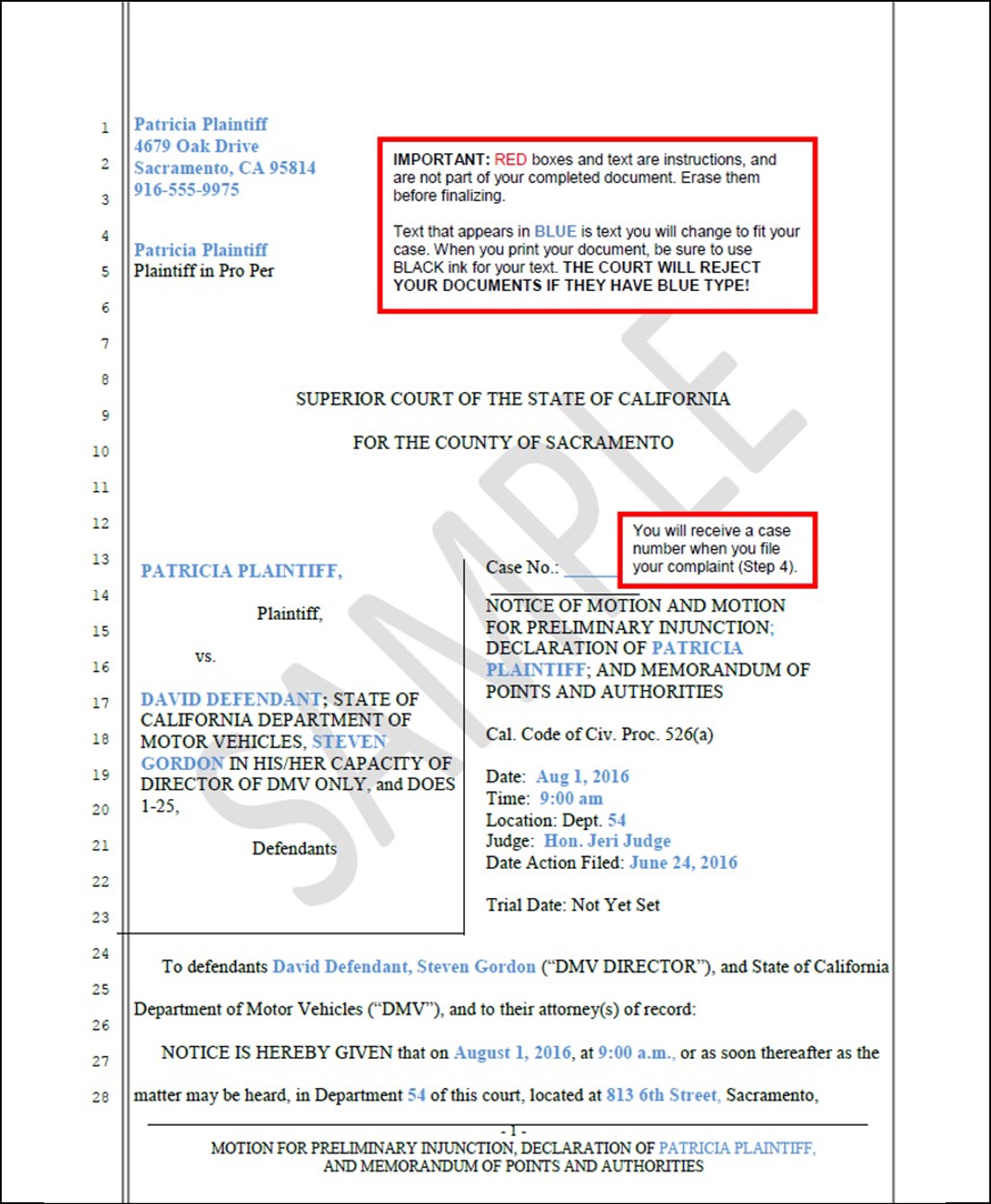
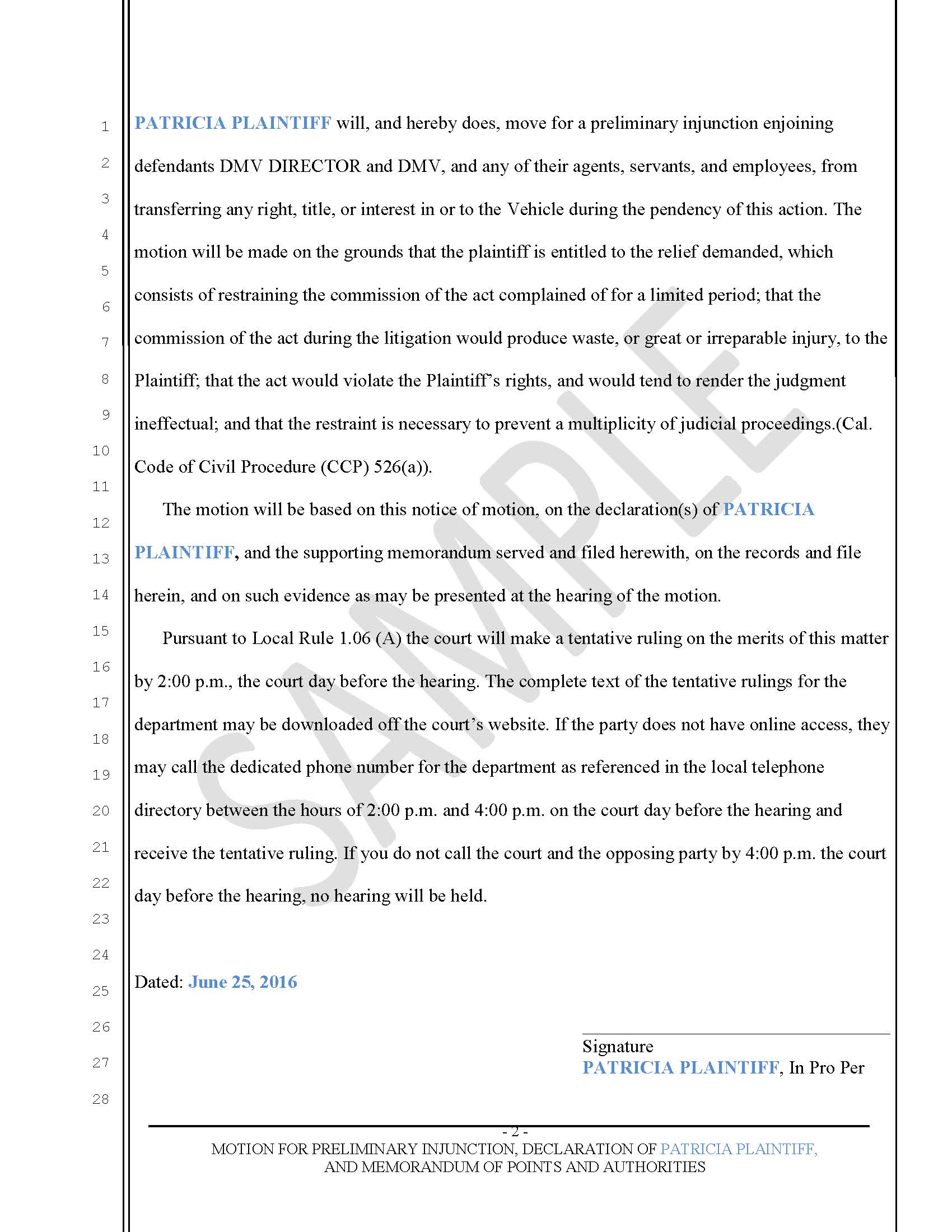
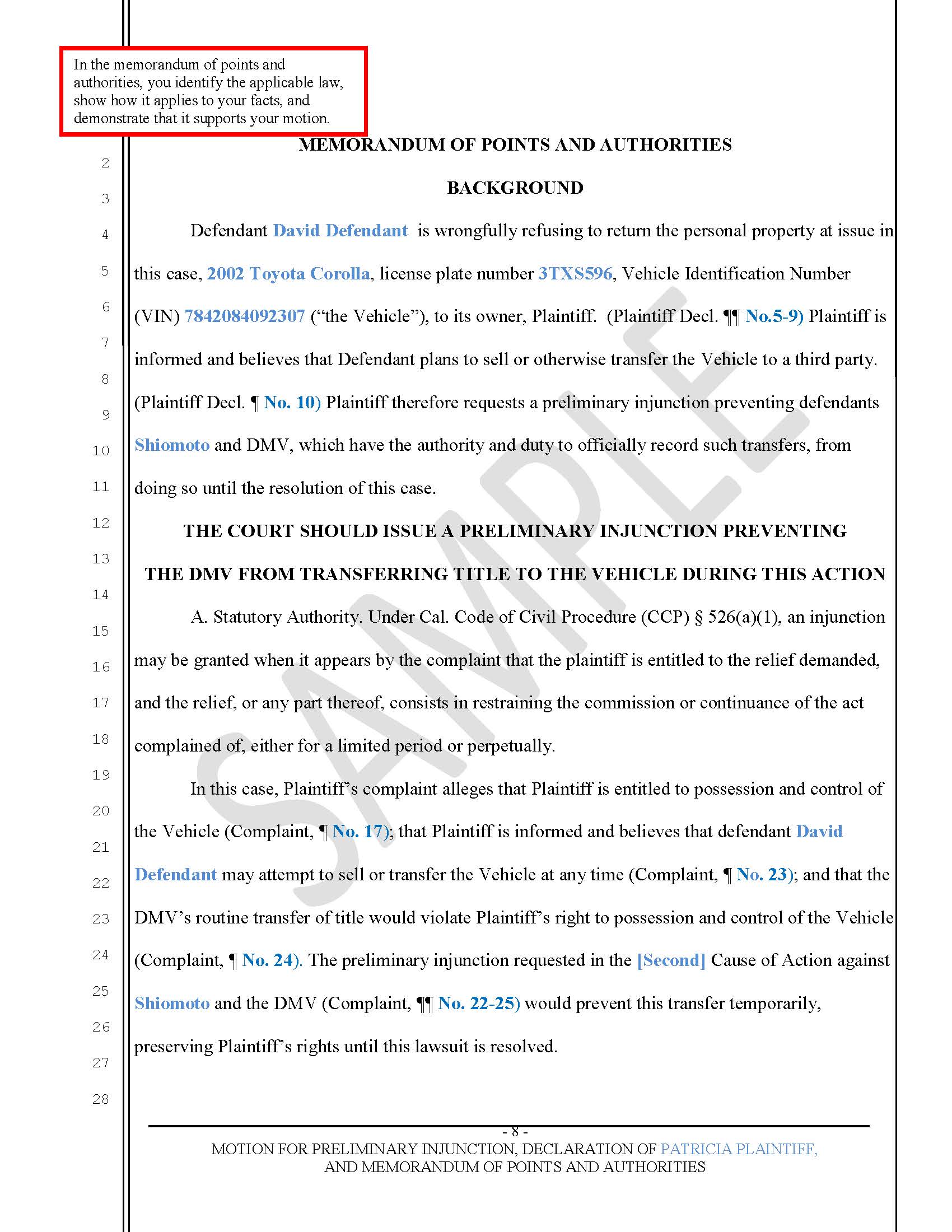
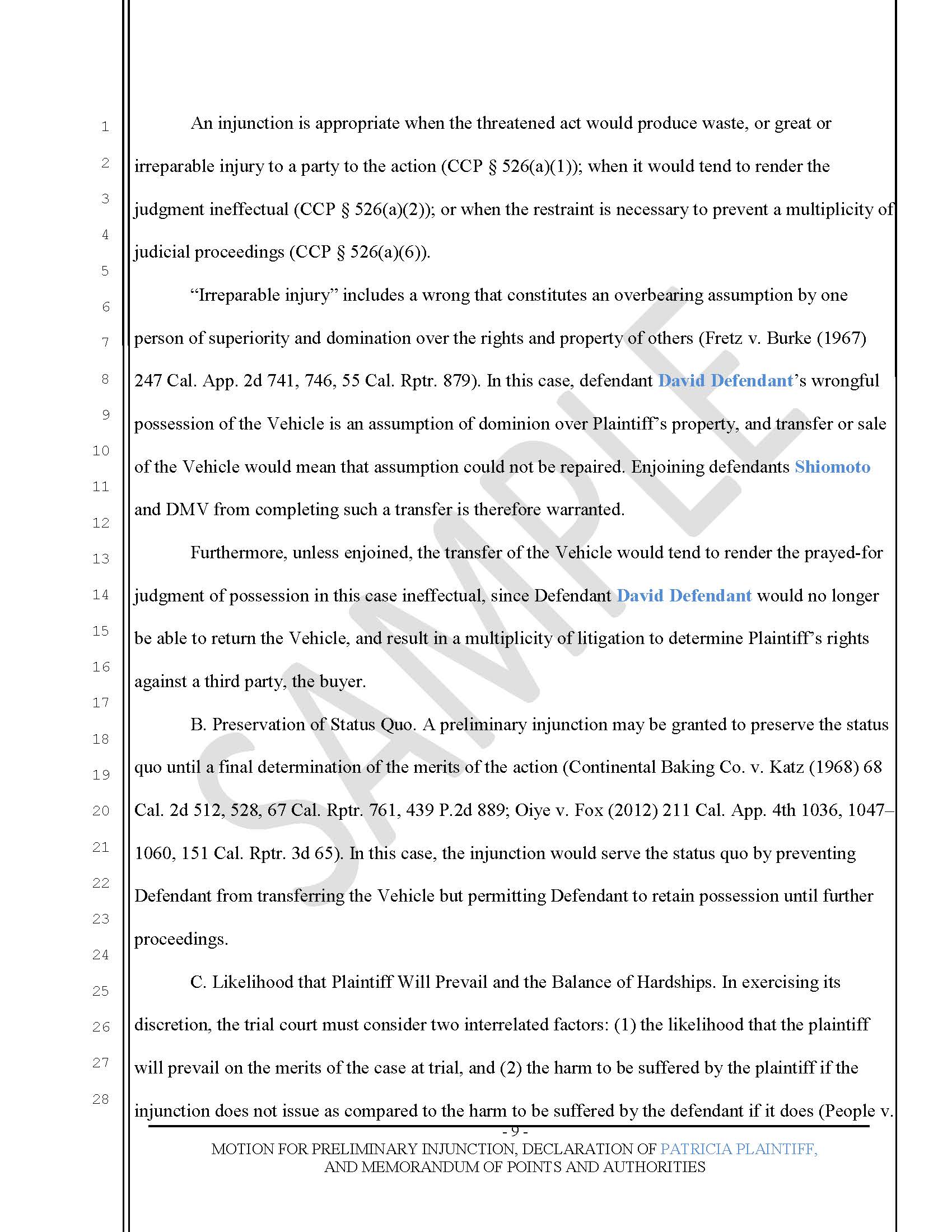
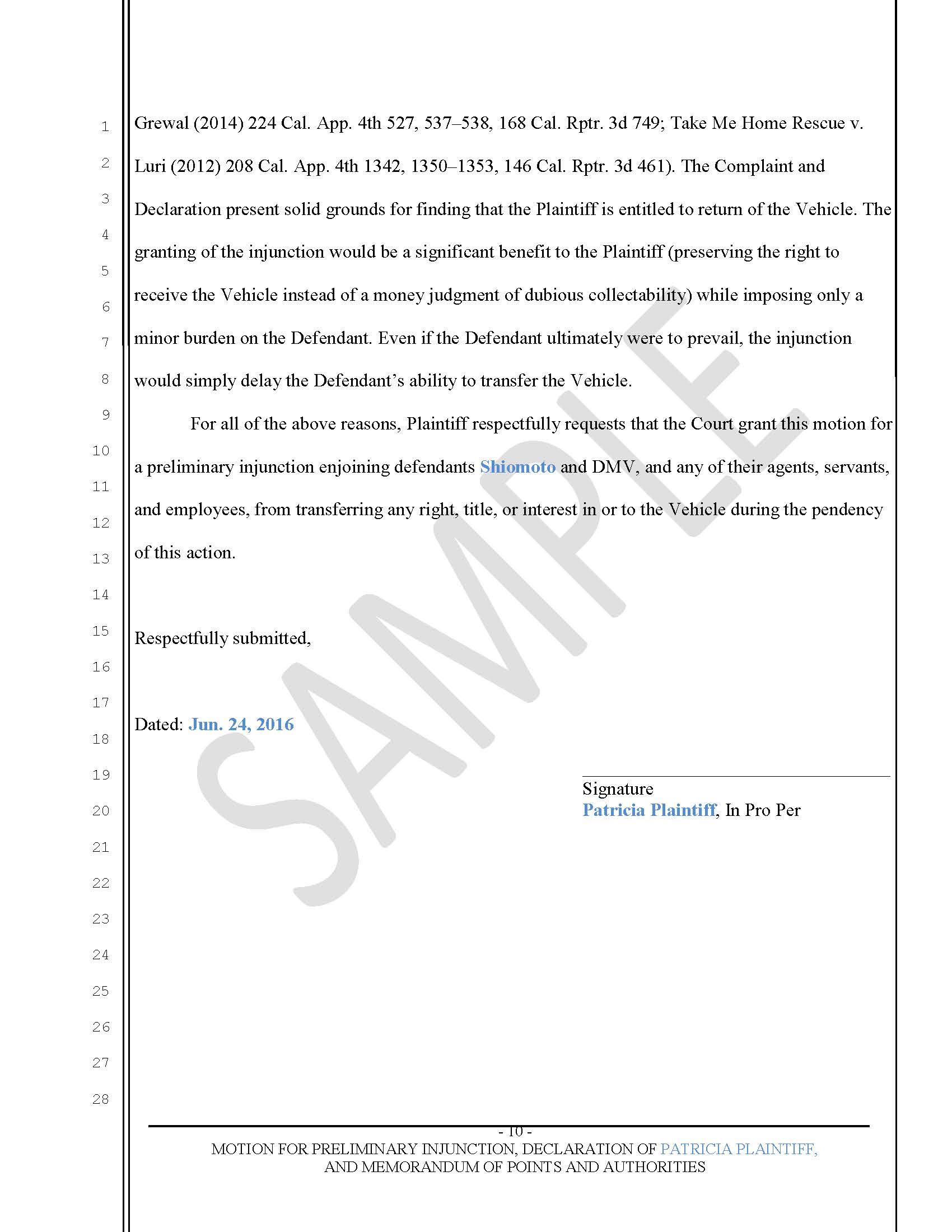
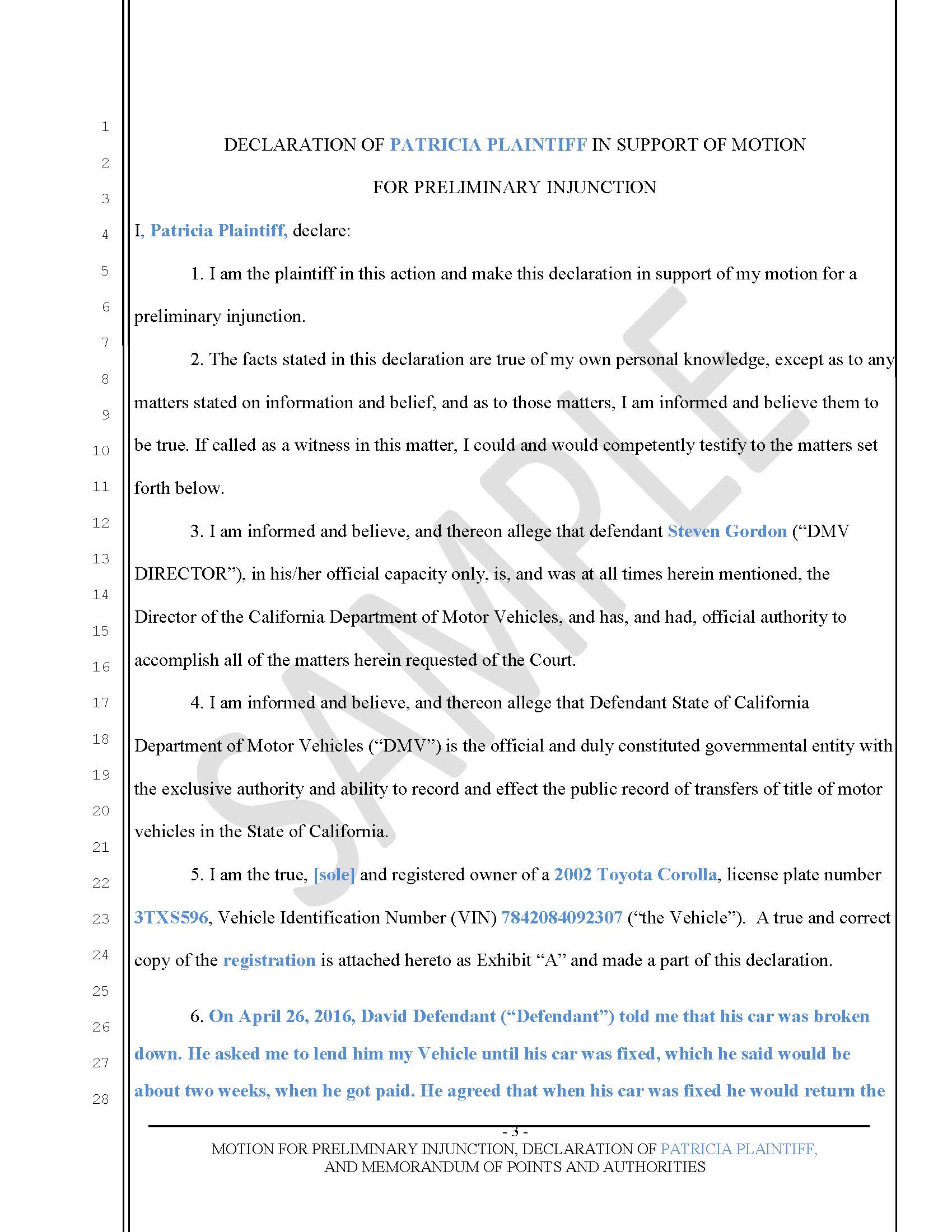
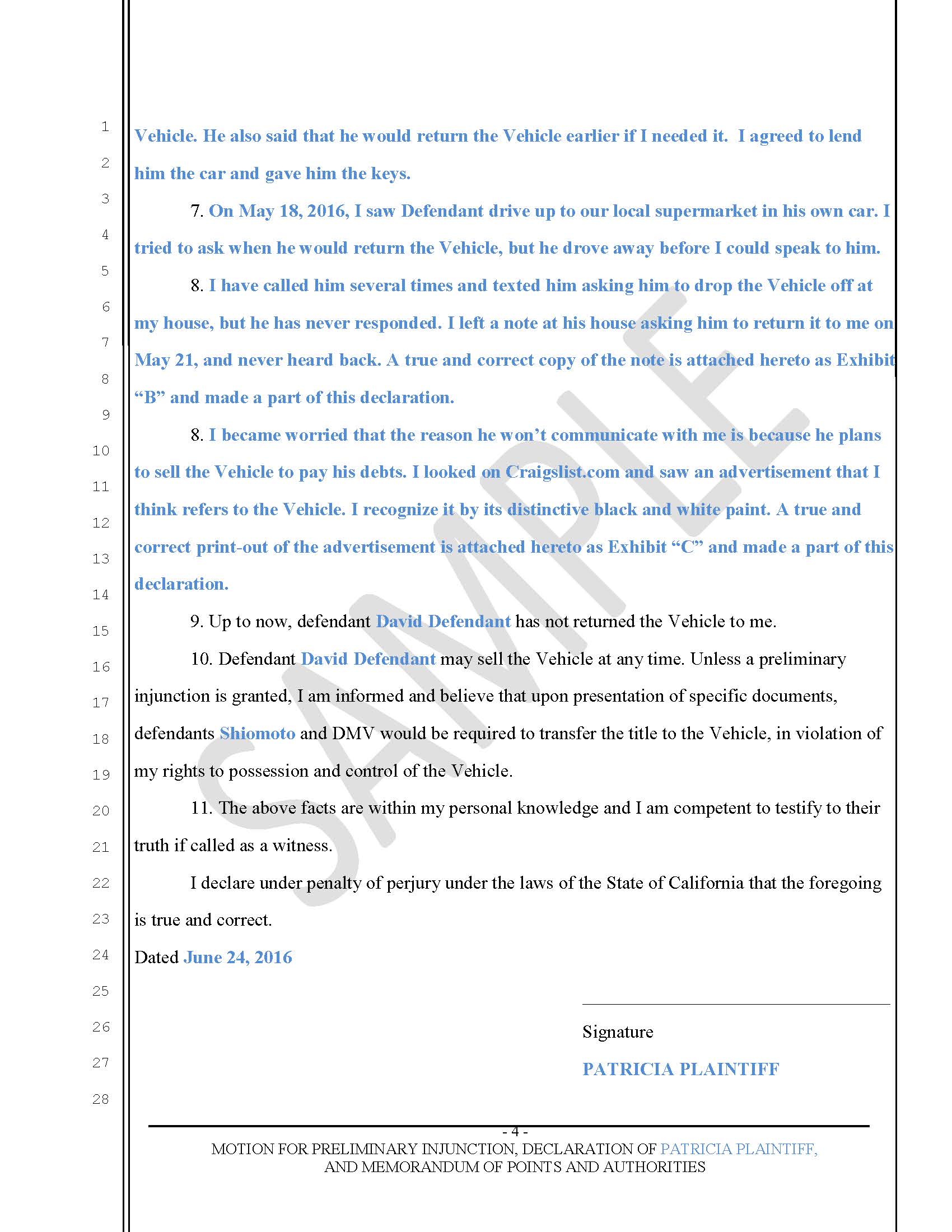

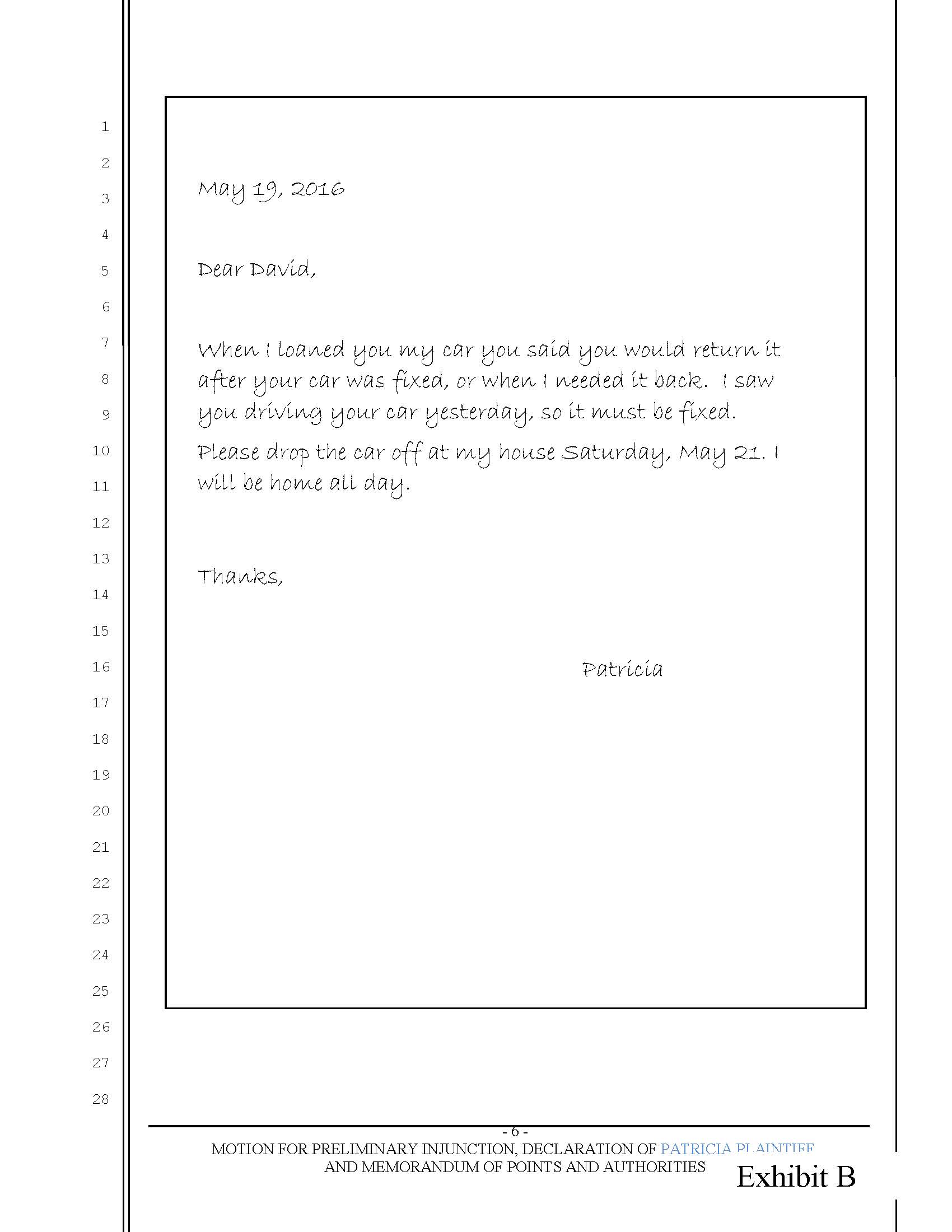
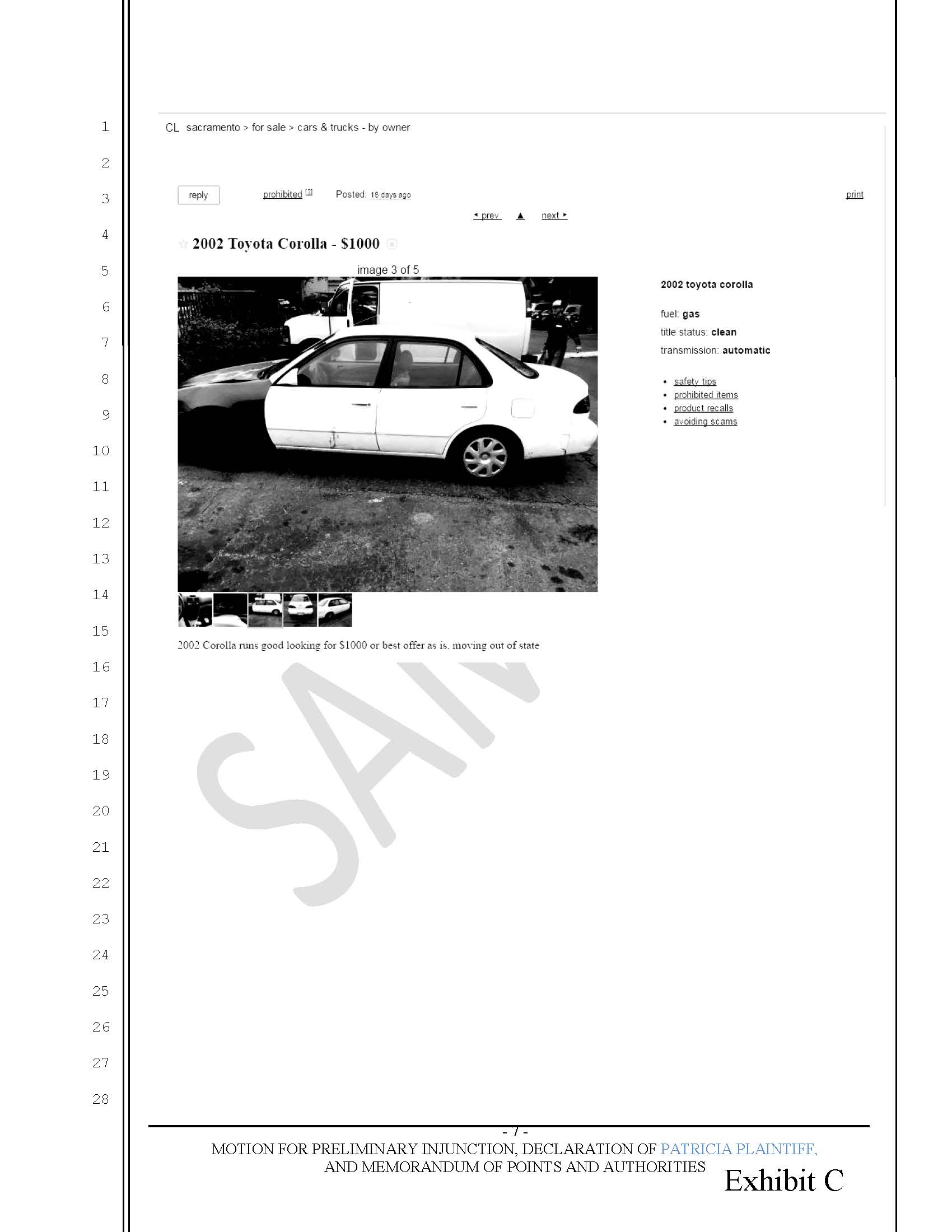
Order for Preliminary Injunction
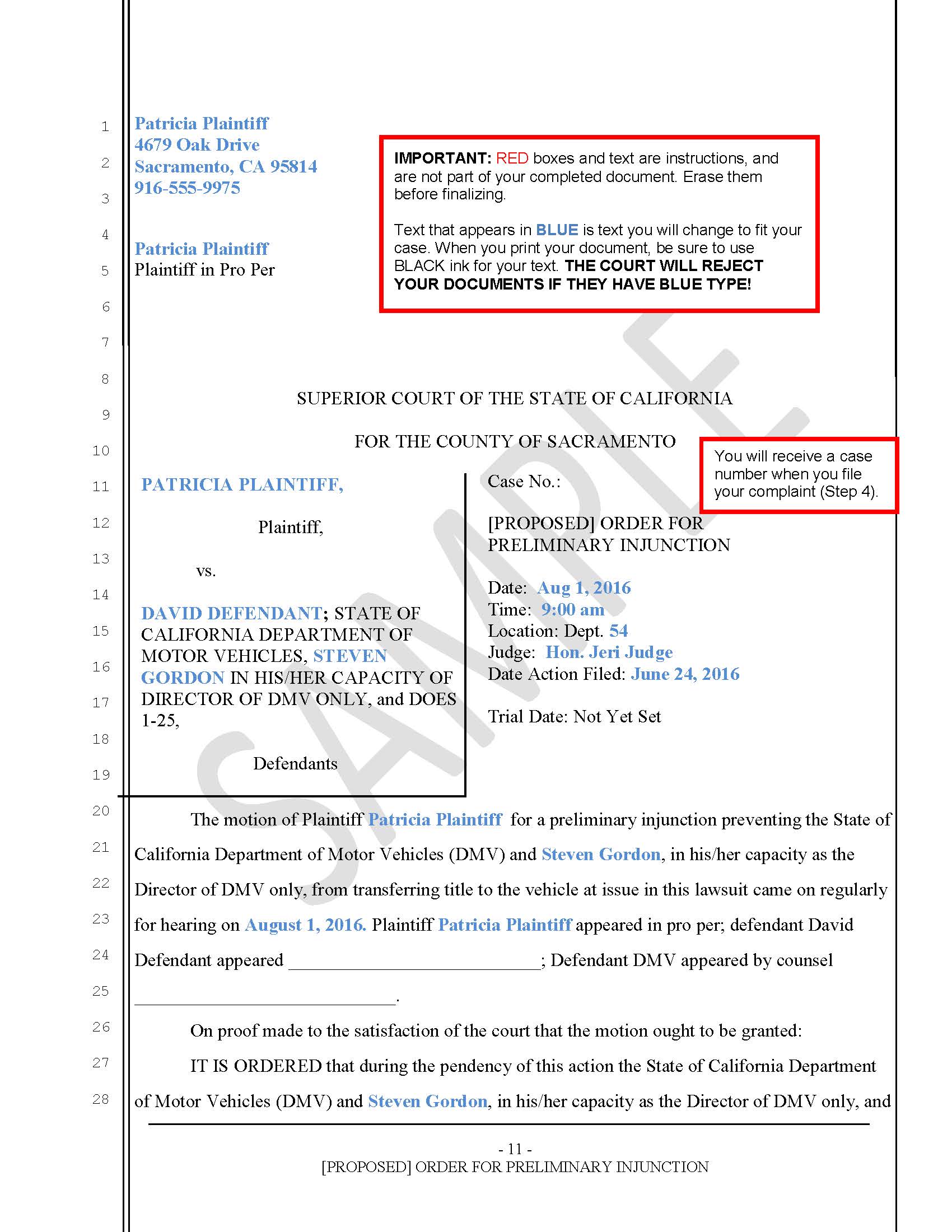
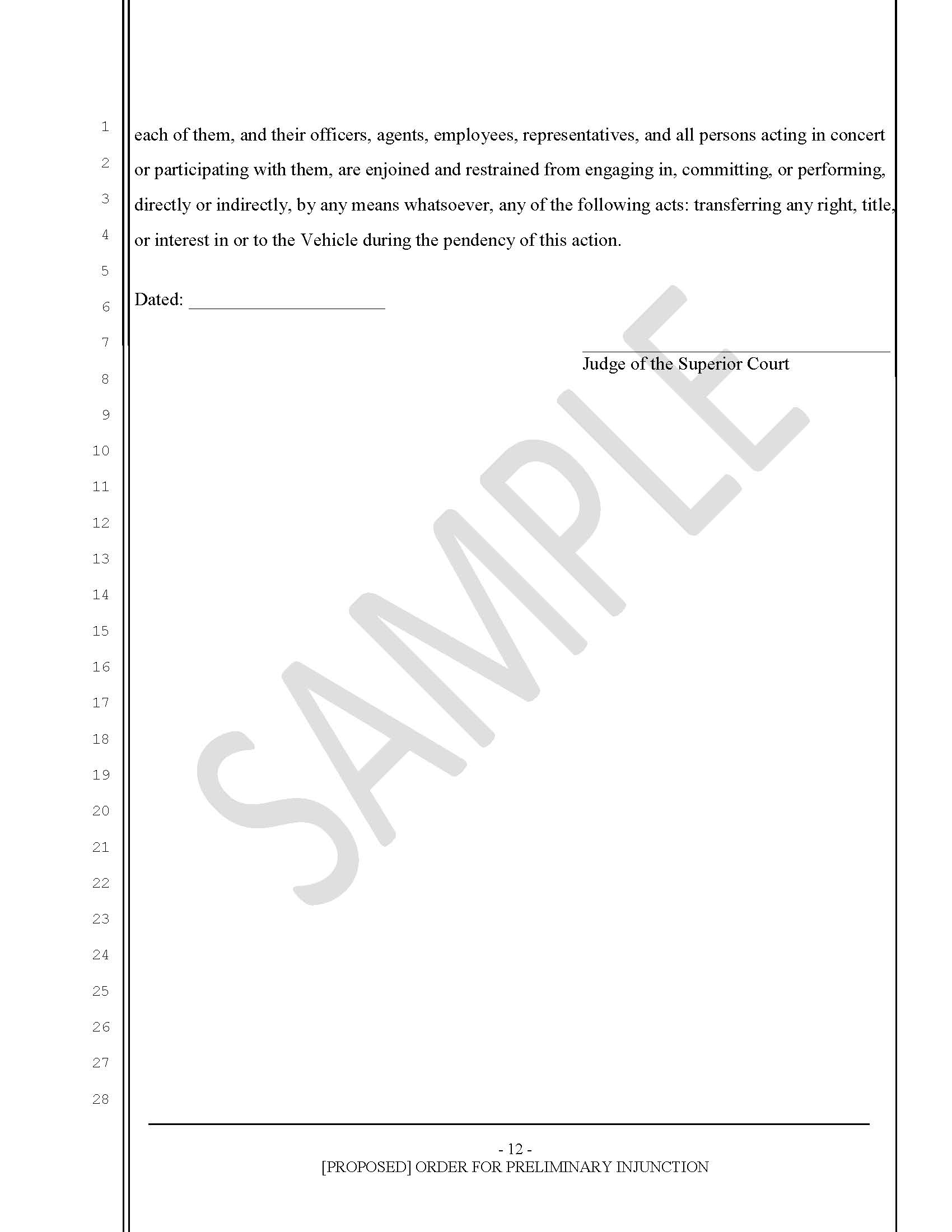
This material is intended as general information only. Your case may have factors requiring different procedures or forms. The information and instructions are provided for use in the Sacramento County Superior Court. Please keep in mind that each court may have different requirements. If you need further assistance consult a lawyer.




